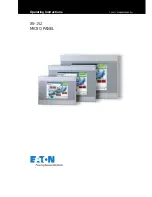
Kontrolle von Rund- und Planlauf
Die erreichbare Genauigkeit des Vario D hängt vor allem vom
Zustand des Kegels und Planfläche im Kraftspannfutter ab.
Hierbei
ist
der
Einfluss
von
Verschleißmarken
und
Beschädigungen ebneso zu sehen, wie Verschmutzungen.
Um die Genauigkeit zu kontriollieren, muss der Zugbolzen
und die Segmentspannbüchse entfernt werden.
Zugbolzen mit Innensechskantschlüssel losdrehen und ent-
fernen. Segmentspannbüche herunterziehen.
Entfernen des Werkstückanschlages indem die Schrauben
entfernt werden.
Für den Planlauf die Messuhr auf die axiale Anschlagfläche
des Anschlags aufsetzen.
Für den Rundlauf die Messuhr auf den Außenkegel des
Dornkörpers aufsetzen.
Monitoring radial and axial run-out
The achievable accuracy of the Vario D depends mainly on
the condition of the taper and the end face in the power
chuck. During this, the influence of wear marks and damage
becomes visible, as do dirty areas.
To monitor the accuracy, the clamping bolt and the segmen-
ted clamping sleeve must be removed.
Loosen clamping bolt with hexagon socket key and remove.
Pull down segmented clamping sleeve.
Removal of workpiece back stop by removing screws.
For axial run-out, place dial indicator onto the axial back stop
surface of the back stop.
For radial run-out, place the dial indicator onto the external
taper of the mandrel body.
12
Vario D
1. Spannbacke (Pos. 2) aus dem Futter entfernen und
Schutzbacken (Pos 82) bis zur max. Position (Markierung
am Futtergesicht) einsetzen.
Beim Wechseln der Schutzbüchse beziehungs-
weise der Vario-Komponente wird die Futter-
mechanik geöffnet. Es dürfen dabei keine
Späne in die Futtermechanik eindringen.
2. Schutzbüchse (Pos. 4) entfernen. Dazu die Schrauben
(Pos. 43) entfernen und in die daneben liegenden
Gewinde einschrauben um so die Schutzbüchse abzu-
drücken.
3. Den Kegel, die Planflächen und den Bajonett vor der
Montage reinigen.
4. Die Vario Komponente so in das Spannfutter einführen,
dass die Markierung am Umfang des Vario zur
Grundbackenführung hin ausgerichtet ist. In dieser
Position kann der Bajonett ineinander geschoben werden.
5. Vario ca. 60° verdrehen, bis Schraubengewinde koaxial
übereinanderliegen.
6. Vario mit 3 Schrauben (Pos. 48) am Futtergesicht fest-
schrauben (Schrauben: DIN EN ISO 4762 - M10-10.9. Mit
Drehmoment 53 Nm anziehen). Die Variokomponente
wird spielfrei im Spannfutter fixiert.
7. Den Spanndruck an der Hydraulik auf die Betätigungskraft
des Vario umstellen.
Demontage des Vario D
Die Demontage vom Spannfutter erfolgt sinngemäß in um-
gekehrter Reihenfolge.
Nach dem Reinigen und Einölen empfehlen wir die Aufbe-
wahrung in einer geschlossenen Box.
1. Remove chuck jaw (Item 2) from the chuck and insert pro-
tective jaws (Item 82) up to the max. position (marking on
the chuck face).
The chuck mechanism is opened when chan-
ging the center sleeve or the Vario component.
When doing this, ensure that no chippings
enter the chuck mechanism.
2. Remove the protective sleeve (Item 4). For this purpose,
remove the screws (Item 43) and screw into the adjacent
threads to press out the protective sleeve.
3. The taper, the end faces and the bayonet must be clean-
ed before mounting.
4. Insert the Vario component into the chuck so that the
marking on the perimeter of the Vario is aligned towards
the guiding of the base jaw. In this position, the bayonet
can be telescoped.
5. Turn the Vario by approx. 60° until the screw threads are
coaxially aligned above each other.
6. Screw the Vario to the chuck face with 3 screws (Item 48).
The Vario component is fixed inside the chuck free from
play.
7. Switch the clamping pressure on the hydraulics to the
actuation force of the Vario.
Removing the Vario D
Removal from the chuck is carried out in reverse order accor-
dingly.
After cleaning and lubricating, we recommend storage in a
closed box.
Type
Max. Betätigungskraft
Vario D0
10 kN
Vario D1
10 kN
Vario D2
20 kN
Vario D3
25 kN
Type
Max. actuating force
Vario D0
10 kN
Vario D1
10 kN
Vario D2
20 kN
Vario D3
25 kN
ACHTUNG:
Die max. axiale Betätiungskraft darf folgende
Werte nicht überschreiten.
CAUTION:
The max. axial actuating force must not exceed
the following values.







































